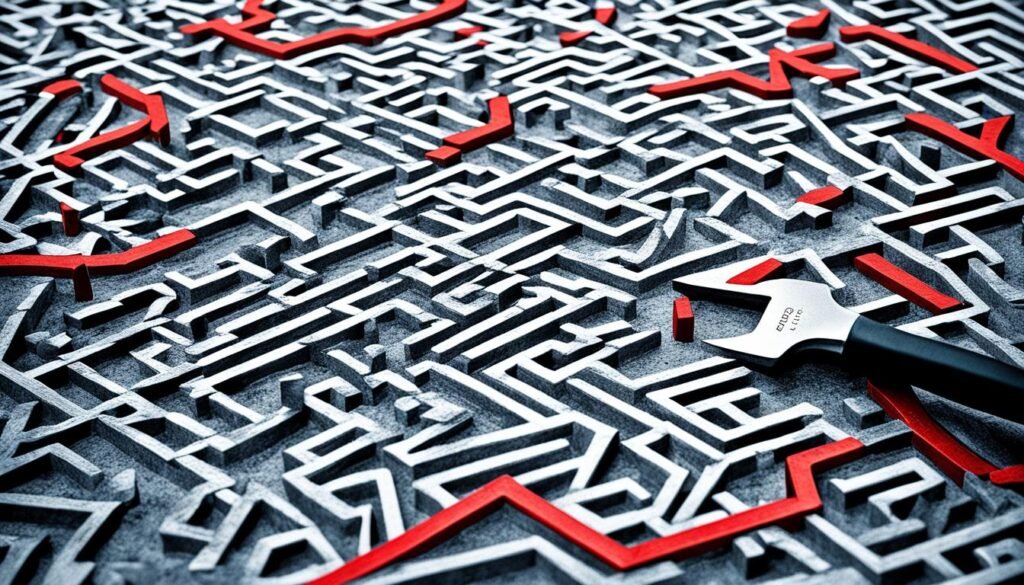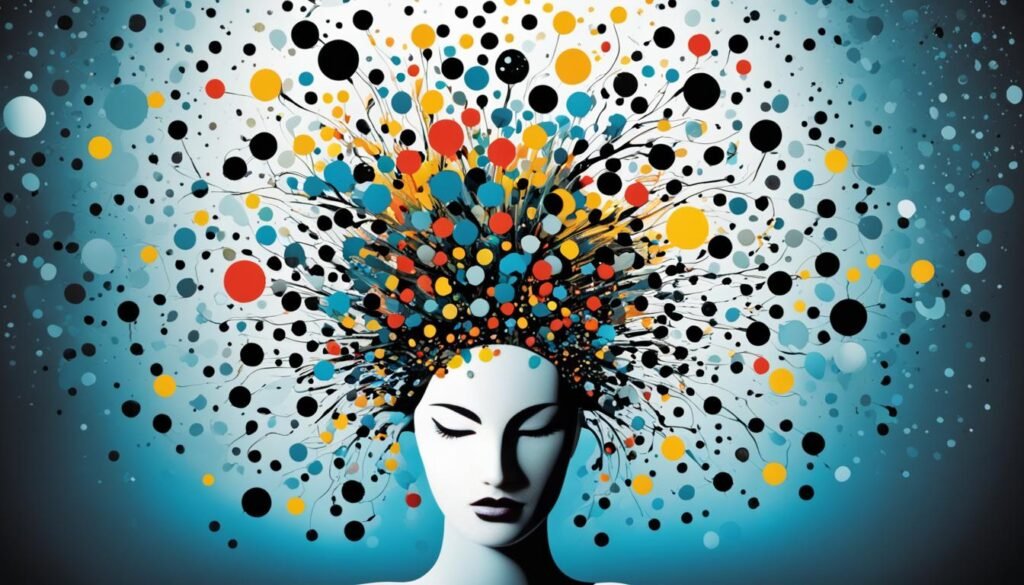Did you know Cognitive Behavioral Therapy (CBT) helps with many mental health issues like anxiety, depression, and obsessive-compulsive disorder1? This therapy changed mental health care since the 1960s, thanks to Aaron T. Beck and Albert Ellis1. As a mental health expert, I’ve seen how CBT changes lives by changing thought patterns and helping with personal growth.
CBT looks at how our thoughts, feelings, and actions are linked2. By spotting and changing negative thoughts, people can find better ways to cope and feel better overall. This therapy is short, usually 12-16 sessions, making it a quick way to get better2.
CBT is very flexible. It’s not just for mental health issues; it can also help with stress, relationship problems, and sleep issues2. People learn skills like changing negative thoughts and facing fears, which help them manage their thoughts and actions better3.
What makes CBT stand out is its solid scientific support. Many studies prove it’s a top treatment for mental health issues, leading to lasting changes and preventing future problems3. This is why many mental health experts and those seeking help choose CBT for its reliability and effectiveness.
Key Takeaways
- CBT is an evidence-based treatment for various mental health conditions
- It focuses on the connection between thoughts, emotions, and behaviors
- CBT typically involves short-term therapy of 12-16 sessions
- Techniques include cognitive restructuring and exposure therapy
- CBT offers long-lasting improvements and helps prevent relapse
- It’s versatile, addressing issues from anxiety to relationship problems
Understanding Cognitive Behavioral Therapy
Cognitive Behavioral Therapy (CBT) is a strong therapy based on evidence that changes how we think and act. It’s a popular type of therapy that uses focused sessions to help with mental health issues4.
Definition and Core Principles
CBT focuses on changing negative thoughts. It helps people learn new ways to cope, feel better, and live more effectively5. By spotting and fixing wrong thinking patterns, CBT boosts confidence and leads to better behavior.
Historical Development of CBT
CBT came from combining cognitive and behavioral therapies. It has grown over many years, thanks to psychologists like Aaron Beck and Albert Ellis. Now, it’s known for its straightforward way of tackling mental health issues.
Scientific Evidence Supporting CBT
Many studies show that CBT works well for different mental health problems. It’s great for treating depression, anxiety, phobias, PTSD, and eating disorders5. You can use CBT on its own or with medication, making it a flexible choice5.
| Condition | CBT Effectiveness | Treatment Duration |
|---|---|---|
| Depression | High | 5-20 sessions |
| Anxiety Disorders | Very High | 8-15 sessions |
| PTSD | Moderate to High | 12-16 sessions |
CBT does more than just help with mental health. It’s also good at managing chronic physical symptoms and illnesses, showing its wide range of benefits5.
“CBT empowers individuals to become their own therapists, equipping them with tools to overcome challenges long after formal sessions end.”
The Foundations of CBT: Thoughts, Emotions, and Behaviors

CBT makes emotional processes simpler by focusing on thoughts, feelings, and behaviors6. This therapy shows how these elements work together to shape our emotions6. Knowing this connection is key for changing our thoughts and managing feelings.
The cognitive triangle shows how thoughts affect feelings, which then lead to actions6. For example, negative thoughts can make us feel bad and act in ways that make us feel worse, creating a cycle6. This cycle is common in anxiety disorders, where avoiding things because of bad feelings can make anxiety worse6.
“CBT has been found effective in a large number of outcome studies for various psychiatric disorders including depression, anxiety disorders, eating disorders, substance abuse, and personality disorders.”
CBT is not just for mental health. It helps with serious mental issues like bipolar disorder and schizophrenia when used with medication7. The effectiveness of CBT is also seen in treating chronic pain and insomnia7.
Understanding CBT helps us manage our moods and break bad emotional cycles6. By analyzing these elements, we learn to handle tough situations better6. This is key to changing negative patterns and promoting positive change.
| CBT Component | Description | Impact |
|---|---|---|
| Thoughts | Mental processes and cognitions | Influence emotions and behaviors |
| Emotions | Feelings and affective states | Shape thoughts and drive actions |
| Behaviors | Actions and reactions | Reinforce thoughts and emotions |
How CBT Differs from Other Therapeutic Approaches
CBT is a standout in psychotherapy. It zeroes in on today’s life, not yesterday’s events. People learn to help themselves with exercises and homework.
Comparison with psychoanalysis
CBT is more structured than psychoanalysis. It usually has 6 to 20 sessions, each 30 to 60 minutes long8. This method quickly tackles specific issues, often needing fewer sessions than other therapies.
CBT vs. medication-based treatments
Medications help, but CBT offers lasting benefits. It teaches people to face fears and change negative thoughts. It also helps them apply what they’ve learned in everyday life after treatment8. CBT is great for treating anxiety, OCD, phobias, panic disorder, PTSD, and sleep problems9.
Integration with other therapies
CBT can stand alone or be mixed with other therapies. For example, Dialectical Behavior Therapy (DBT) combines CBT with mindfulness from Buddhism and Zen9. This mix works well for those with borderline personality disorder and serious suicidal thoughts.
| Therapy Type | Focus | Duration | Best For |
|---|---|---|---|
| CBT | Current situations | 6-20 sessions | Depression, Anxiety |
| Psychoanalysis | Past experiences | Long-term | Deep-rooted issues |
| DBT | Emotional regulation | Weekly sessions | Borderline Personality Disorder |
In comparing psychotherapies, CBT shines as a flexible and effective method. Its focus on now and structured approach wins over many mental health experts. The fact that 72.7% of people chose CBT in 2021-22 shows its success10.
Key Techniques Used in Cognitive Behavioral Therapy

Cognitive Behavioral Therapy (CBT) uses several techniques to change thinking and behavior. These include cognitive restructuring, exposure therapy, and behavioral activation.
Cognitive restructuring is key in CBT. It helps patients change negative thoughts to more balanced ones. I help them see distorted thinking patterns and adopt healthier views.
Exposure therapy is great for anxiety and phobias. I help patients face their fears step by step in a safe place. This builds confidence and lowers anxiety.
Behavioral activation is vital for depression and mood disorders. I help set goals and encourage positive actions. This breaks the cycle of avoiding and doing less that comes with depression.
CBT is a short-term therapy, with most seeing results in weeks to months11. Sessions are about an hour long and happen weekly, depending on what each person needs11. Studies show improvements in five to 20 sessions, making it a quick and effective treatment12.
CBT is versatile and works well for many conditions like anxiety, depression, eating disorders, and substance use disorders1112. A 2018 study of 41 studies found CBT greatly helped people with anxiety and related disorders12.
While CBT has many benefits, it requires commitment. Patients must be ready to work on their thoughts and feelings12. But the benefits are big. CBT improves thinking, gives coping skills, and is a cost-effective treatment12.
The Role of Mindfulness in CBT
Mindfulness-based CBT combines traditional CBT with meditation and being aware of the present moment. This helps people notice their thoughts and feelings without judging them. Adding mindfulness to CBT makes it more effective.
Incorporating Mindfulness Practices
MBCT is an eight-week program with weekly classes and a special day-long session13. In these classes, people learn how to be mindful in everyday life. They learn techniques like:
- Body scans
- Meditation
- Mindful stretching
They also do homework outside of class, like listening to guided meditations13.
Benefits of Mindfulness-based CBT
MBCT has big benefits. It can cut the risk of depression coming back by almost half13. It’s as good as taking antidepressants in stopping depression from happening again13. Studies show it helps reduce depression and cravings for addictive substances13.
Techniques for Cultivating Present-Moment Awareness
Being in the moment is key in mindfulness-based CBT. I use mindful observation with clients. For example, they might watch a paperclip and let their anxiety be14. This helps them accept their anxiety and focus on the world around them.
Another technique is engaging fully in activities. A client of mine used mindfulness to handle her anxiety while hiking14. This shows how mindfulness can be a part of therapy for everyone.
Even though mindfulness is popular for mental health, finding MBCT therapists can be hard in some places13. But, many therapists use mindfulness in their work, even if they’re not MBCT trained.
Cognitive Restructuring: Challenging Negative Thought Patterns

Cognitive restructuring changes how we think. It’s a big part of cognitive behavioral therapy (CBT) that helps us spot and fight negative thoughts15.
Often, negative self-talk comes from cognitive distortions. These are not logical thoughts and are linked to feeling down and anxious15. By noticing these distortions, we can begin to change our thinking.
Using thought records is a good way to track our experiences and challenge these negative thoughts15. Another method is Socratic questioning, where we question our thoughts with specific questions1615.
“Thought challenging is not about positive thinking. It’s about realistic thinking.”
Studies show that cognitive restructuring works as well as CBT for fighting depression17. It also helps reduce stress and boosts confidence16.
| Technique | Description | Benefits |
|---|---|---|
| Thought Records | Track experiences and thoughts | Identify patterns in thinking |
| Socratic Questioning | Challenge thoughts with probing questions | Evaluate evidence for thoughts |
| Guided Imagery | Visualize positive scenarios | Reduce anxiety and stress |
You can do cognitive restructuring by yourself or with a therapist. There are also apps and online tools to help17. If you’re really struggling, it’s best to get help from a professional17.
By practicing cognitive restructuring, we can change our thought patterns and better our mental health. It’s a key skill for growing personally and handling mental health issues.
Behavioral Activation: Encouraging Positive Actions
Behavioral activation is a key part of CBT that boosts positive actions. It helps break the cycle of feeling down and anxious by getting you to do things you enjoy. Studies show it works as well as medicine and a bit better than talking therapy for depression18.
Setting Achievable Goals
Setting goals is vital in behavioral activation. I help clients pick and plan fun or important activities. We increase how often and how complex these activities are. Planning and scheduling positive actions helps make them happen18.
Overcoming Avoidance Behaviors
Bad events can lead to not getting enough positive feedback, causing depression. Behavioral activation aims to increase positive feedback and stop behaviors that make depression worse18. It has shown good results in many areas:
- Older adults with depression got better, especially with one-on-one activities19.
- Smokers who used behavioral activation were more likely to quit (30%) than those with CBT alone (18%)19.
- People with a history of substance abuse did better in staying sober with behavioral activation19.
Reinforcing Positive Experiences
Positive reinforcement is crucial for changing behavior. I help clients swap unhelpful actions for ones that feel good or give a sense of achievement. Having support from others helps clients keep up with their plans18.
| Behavioral Activation Strategies | Benefits |
|---|---|
| Increasing pleasure and meaning | Improved mood and life satisfaction |
| Replacing unhelpful behaviors | Reduced negative thought patterns |
| Improving relationships | Enhanced social support and well-being |
Regular check-ins are key to seeing progress and fixing any plan issues. As clients do better, we move to harder positive activities with lasting benefits18.
Stress Management and Coping Strategies in CBT

Cognitive Behavioral Therapy (CBT) helps us deal with stress in our busy lives. Many Americans feel more stressed now than before, and it affects their health, work, and personal relationships20. CBT teaches us how to handle anxiety, depression, and stress better, making it easier to make good choices when things get tough21.
CBT uses different ways to help us relax. One method is diaphragmatic breathing, which means taking deep breaths that make your diaphragm drop. This helps you relax. Another way is progressive muscle relaxation (PMR), where you tense and then relax different muscles to feel less anxious21.
Behavioral activation is a key part of CBT. It means doing things you enjoy to make you feel better and fight off depression. Changing negative thoughts into positive ones is another important part of CBT. Setting goals that are easy to achieve is also key, helping you stay focused without feeling overwhelmed21.
| CBT Technique | Purpose | Benefits |
|---|---|---|
| Diaphragmatic Breathing | Stress Relief | Improves attention, reduces negative affect |
| Progressive Muscle Relaxation | Anxiety Reduction | May alleviate depression in certain conditions |
| Behavioral Activation | Mood Enhancement | Effective for depression and anxiety |
Studies show that Cognitive Behavioral Stress Management (CBSM) can really improve life for people with ongoing health issues. It lowers stress, helps avoid negative coping, and boosts positive ways of thinking22. By using these skills regularly, people can better handle stress and live healthier lives.
Emotional Intelligence and CBT: Enhancing Self-Awareness
Cognitive Behavioral Therapy (CBT) is key in boosting emotional intelligence. This is vital for success in both personal and professional life. It focuses on understanding emotions and managing them. This improves how we interact with others and our overall happiness23.
Recognizing and Labeling Emotions
CBT teaches us to spot and name our feelings. It has four steps: awareness, analysis, action, and evaluation24. Keeping an emotion diary and practicing mindfulness helps us get better at understanding our feelings.
Developing Emotional Regulation Skills
Handling our emotions is a big part of emotional intelligence. CBT gives us tools to manage our feelings well. Tools like the thought record help us fight negative thoughts with positive ones24. This makes us better at controlling ourselves and making good choices.
Improving Interpersonal Relationships
Being more emotionally intelligent means we do better in social situations and relationships23. CBT helps us become more empathetic and communicate better. These skills are super useful for leaders, helping create a positive work culture and strong teams25.
| Emotional Intelligence Component | CBT Technique | Benefit |
|---|---|---|
| Self-Awareness | Emotion Diary | Improved Emotional Recognition |
| Self-Regulation | Thought Records | Better Emotional Control |
| Empathy | Perspective-Taking Exercises | Enhanced Interpersonal Skills |
Getting better at emotional intelligence with CBT takes time and effort. By going to therapy, doing exercises, and using what we learn in real life, we can really improve. We’ll get better at understanding ourselves, managing our feelings, and getting along with others25.
CBT for Specific Mental Health Conditions

Cognitive Behavioral Therapy (CBT) is a powerful tool for treating mental health issues. It helps 75% of patients feel much better, and 60% learn skills to handle life’s challenges26. This method is especially helpful for dealing with depression, anxiety, and PTSD.
For depression, CBT can boost mood by 80%26. For anxiety, it helps about 70% of people feel better26. These numbers show how effective CBT is for different mental health problems.
CBT also helps with bipolar disorder, eating disorders, OCD, and schizophrenia. Therapy usually takes 6 to 20 sessions, each 30 to 60 minutes long27. It can be as good as medication for some mental health issues, offering a non-drug option.
About half of those trying CBT see big improvements in 12 to 16 weeks26. This fast progress is good news for those looking for quick relief from mental health issues.
| Condition | Improvement Rate | Treatment Duration |
|---|---|---|
| Depression | 80% | 12-16 weeks |
| Anxiety Disorders | 70% | 12-16 weeks |
| PTSD | 75% | 12-20 weeks |
But, CBT isn’t right for everyone. It might not work well for those with complex mental health issues or learning challenges27. Still, its structured approach makes it flexible, available in group sessions, self-help books, and online. This makes it easier for many to get the help they need.
The Process of CBT: What to Expect in Therapy Sessions

Cognitive Behavioral Therapy (CBT) is a structured way to change thoughts and actions. It helps with many issues like mood, anxiety, and substance abuse28.
Initial Assessment and Goal Setting
The first step is an assessment to set goals for treatment28. This is key to making therapy fit your needs. Your therapist might use tests and self-tracking to see how you’re doing28.
Typical Session Structure
CBT is focused and usually lasts a few months28. It can have 6–20 sessions, depending on what you need29. Each session has a plan:
- Reviewing homework from last time
- Setting goals for the session
- Working on issues with CBT methods
- Getting new homework
Homework and Between-Session Exercises
Homework is a big part of CBT. You do exercises outside of sessions to help you remember what you learned28. These might be about changing thoughts, solving problems, or being mindful28.
| CBT Component | Purpose | Examples |
|---|---|---|
| Initial Assessment | Establish baseline and goals | Questionnaires, interviews |
| Session Structure | Maintain focus and progress | Agenda setting, feedback |
| Homework | Practice and skill development | Thought records, exposure tasks |
CBT is seen as the best therapy, backed by lots of research29. By taking part in planning and doing exercises at home, you can get the most out of this helpful therapy.
Online CBT and Self-Help Resources
In today’s digital world, digital therapy has changed how we get mental health help. Now, self-guided CBT is more accessible, letting people help themselves when they need it. Online tools offer interactive workbooks and exercises, similar to what you’d find in traditional CBT sessions.
Think CBT is one example, with a 90-page workbook and over 40 exercises. It covers topics like cognitive distortions and building personal resilience30.
Mental health apps are also key in CBT today. They bring the basics of traditional CBT to your phone, like spotting and fighting negative thoughts31. These apps aren’t a full replacement for seeing a therapist, but they’re great for keeping up with your mental health between sessions or after therapy ends.
Self-guided CBT follows the same steps as traditional CBT, lasting five to ten months with weekly sessions31. This lets users work at their own speed, taking charge of their mental health. Yet, it’s key to remember that these online tools are best used with professional advice for serious mental health issues.
FAQ
What is Cognitive Behavioral Therapy (CBT)?
CBT is a type of therapy that changes negative thoughts and actions to improve mental health. It shows how our thoughts, feelings, and actions are linked. By changing bad thoughts and actions, people can feel better and live better.
What are the core principles of CBT?
CBT’s main ideas are to spot and fight negative thoughts, change bad actions, and learn better ways to cope. It focuses on now, not the past, to tackle current problems.
What techniques are used in CBT?
CBT uses many methods like changing thoughts, doing positive actions, and solving problems. It also includes relaxation, mindfulness, and acting out scenarios. These help people change negative thoughts, act better, and cope in healthier ways.
How does CBT differ from other forms of therapy?
CBT is different because it looks at the present and tackles specific issues, not past ones. It’s a focused, short-term therapy that works with the client closely. It also emphasizes doing homework and learning new skills.
What is the role of mindfulness in CBT?
Mindfulness is added to CBT to make it work better. It helps people notice their thoughts and feelings without judging them. This leads to better control over emotions and stress. Techniques like meditation and deep breathing are used.
How does cognitive restructuring work in CBT?
Cognitive restructuring is a key part of CBT. It helps people spot and question negative thoughts. By changing these thoughts, people can think more positively and feel better emotionally and behave better.
What is behavioral activation in CBT?
Behavioral activation is a CBT method that encourages doing positive things. It sets goals, fights avoiding actions, and celebrates good experiences. This helps people break the cycle of feeling down or anxious by doing things they enjoy.
How does CBT address stress management and coping strategies?
CBT teaches ways to handle stress and cope with tough times. This includes relaxing, solving problems, and building resilience. It gives people tools to deal with stress and challenges in life.
What is the role of emotional intelligence in CBT?
Emotional intelligence is key in CBT for mental health. It means knowing and managing emotions, solving problems, and improving relationships. Being more emotionally aware helps with making better choices and having happier relationships.
What mental health conditions can CBT treat?
CBT can help with many mental health issues like depression, anxiety, phobias, PTSD, and more. It’s customized to fit the specific symptoms and problems of each condition.
